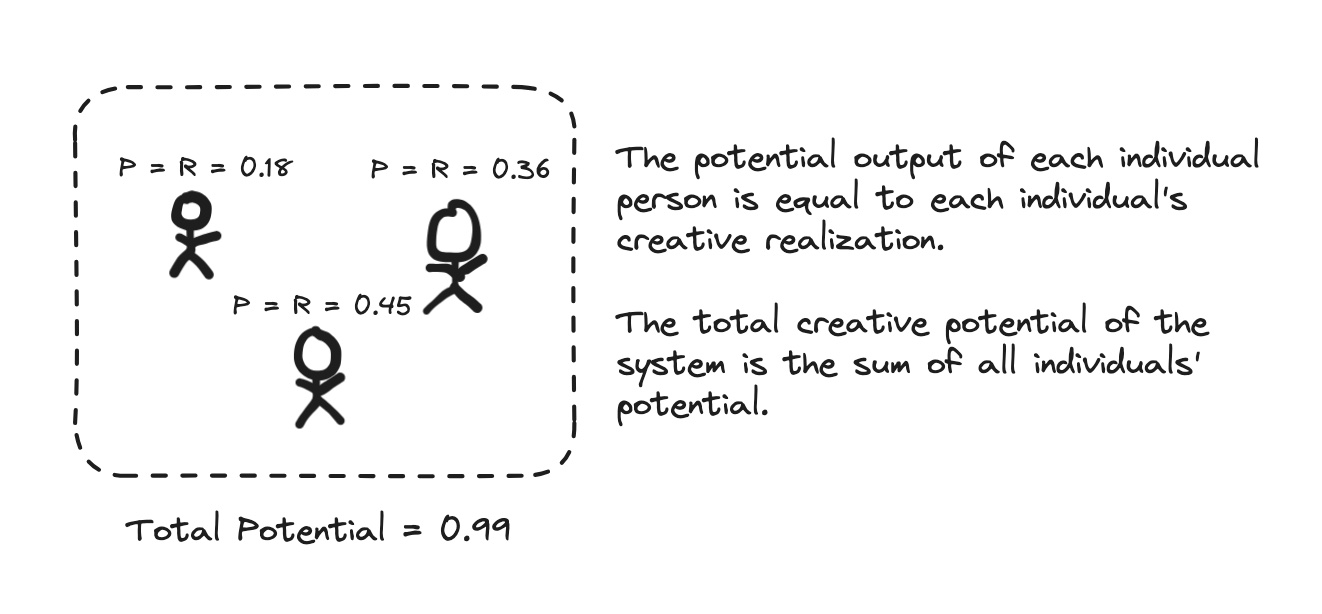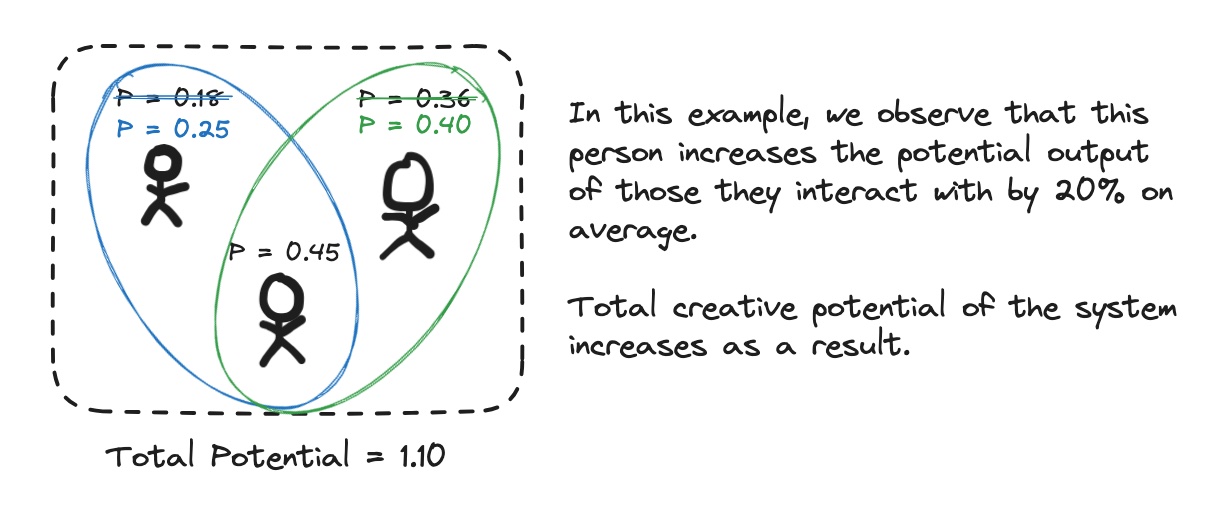A Formula
July 18, 2024My friend Vin talks about how we need to increase the creative throughput of Toronto. I tend to agree. I think much of the frustration people have for the city is because it has the potential to be great, but this potential is unrealized.
First, what is creative output? Let's think of Toronto as a system. A system is made up of the individuals, communities, institutions, and infrastructure within it. What the system as a whole produces is its total creative output.

It's important to note that I use the word creative output to literally mean creating anything of value – music, films, food, apps, games, robots, communities, policy changes, etc.
We can see the greatness of a system like San Francisco that outputs as many technology companies as it does, or one like Los Angeles that creates so many films. Many in Toronto have the ambition for the city's own great outputs, but are unsure how to make it happen.
Below, I propose a simple but elegant formula to understand how. This provides a framework for us to understand issues and propose solutions:

Total Creative Potential, P, is defined as the total potential of a system to do creative things. Similar to how a raised demolition ball has the potential to do a lot of damage, or a drawn bow has the potential to shoot an arrow, a system has the potential to create things.
People yearn for bigger and better things to come out of the system, but the question is how. Intuitively, we know that if you want the demolition ball to do more damage, you raise it higher; if you want the arrow to go farther, you pull the bow back further. Similarly, if we want more creative output, we need to understand how to increase P.
Every person is on their own journey towards their full creative potential. How far along you are on your journey is your creative realization. In Maslow's Hierarchy of Needs, this is known as self‑actualization, and is represented by R. A fully realized person would have an R of 100%. For what it's worth, I think most people, myself included, are 20‑40% realized.
We can think of the total creative potential of the system as the sum of the creative realization of all the individual people within it. Intuively, we can understand that a system with extraordinary people will inevitably produce extraordinary things; a system where everyone is living at a stunted potential will produce few.

Now, at first glance, one might think that maximizing individual performance is sufficient to maximizing the system as a whole. However, consider the saying, "the sum is greater than the parts".
This phenomenon is called emergence in systems thinking. When people work on something together, they can create something bigger and better than what each individual could have made on their own. I think of it as the unintended, unexpected, and magical things that can happen when people work together. This is the creativity multiplier, M.
M can be a function of how effectively you work with others, how many people you work with, how often you collaborate, etc. I will leave it to the reader to derive all the possibilities on their own. Ultimately, it asks, how much of an impact do you make on others? How much do you accelerate other people's ideas, potential, and work?

Interestingly, M can be a positive multiplier (you make things better for everyone) or negative (you make things worse).
Now, let's return back to the original question: how can we make Toronto better?
According to our equation, we need to:
- Increase the number of people in the system
- Maximize every person's creative realization
- Maximize every person's creativity multiplier
The first is straightforward. The second asks that each person be the best that they can possibly be – find the things you can excel at and excel at them. The last asks to improve the ways people interact with each other. This can be done by:
- Collaboration – Each person can increase the number of interactions they have and/or have more meaningful collaborations. There's also something to be said about finding collaborations where you can have outsized impact. For example, I think an expert in their field can have huge multiplying effects on a junior just getting started. Two people who work really well together can have compounding effects on each other. An artist and an engineer can have huge multiples on each other since their skillsets vary so widely.
- Support and resources – Institutions can provide the necessary support and resources for individuals to realize their creative potential. For example, a well‑equipped maker studio can help someone turn their idea into a tangible product. A co-working space can provide the place for people to connect and work together.
- Policy – Effective policies can create the right environments for creativity. For example, by providing funding and grants or reducing bureaucratic barriers.
- Positive feedback loops – People are motivated by seeing other people do cool things. It's a flywheel where seeing success leads to others being inspired to do the same, which leads to more people being inspired, and so on. There must be ways for people to share what they're doing and be inspired by what others are building.
This equation creates a really elegant blueprint for the city. It also gives clear direction to individuals who ask themselves, "what can I do to make Toronto better?" Do things that maximize this equation.
Peer reviews welcome.